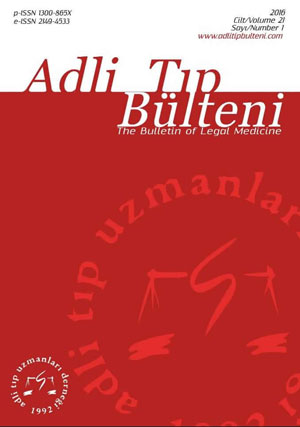Comparison of Extraction Methods for 11-Nor-Delta-9-Tetrahydrocannabinol-9-Carboxylic Acid (Thc-Cooh) in Urine Samples Prior to GC-MS Analysis
DOI:
https://doi.org/10.17986/blm.2016116593Keywords:
tch-cooh, liquid-liquid extraction, solid phase extraction, urine, gas chromatography mass spectrometryAbstract
Objective: Marijuana is the most widely used illegal substance in the world. The target analyte for cannabinoids analysis in urine is THC-COOH. The most widely used sample preparation methods for THC-COOH are liquid-liquid extraction (LLE) and solid phase extraction (SPE). The aim of this work is to compare the extraction methods (LLE and SPE) for (±)-ll-nor-9-carboxy-A9-THC ÇTHC-COOH) for synthetic urine samples (n=80) prior to Gas Chromatography Mass Spectrometry (GC-MS) analysis. In addition, a method validation was conducted in terms of reproducibility, selectivity, accuracy, precision and linearity.
Materials and Methods: (±) -1 l-nor-9-carboxy-A ’-THC and (±) -ll-nor-9-carboxy-A9-THC-D3 (as the internal standard) were used in the studies. Toxi tube B and Clean Screen THC cartridges were used for LLE and SPE, respectively. BSTFA with 1% TMCS were used in the derivatization step. The analysis is performed with Thermo Finnigan Trace GC-MS. Minitabll was used in statistical evaluations.
Results: The limit of detection (LOD) was found to be 2 pg/L. All recovery values were >90% with RSD values <10%. A calibration curve for the standard stock solutions of 25-500 pg/L was obtained with a coefficient of variation (R2) of 0.9968 which indicates a good linearity. The Anderson-Darling test applied indicated that, LLE and SPE results do not follow a normal distribution, therefore, a non-parametric test, Wilcoxon signed-rank test was used in statistical evaluations.
Conclusions: The linearity, repeatability and recovery values obtained in the study were found to be in accordance with bioanalytical validation criteria. According to the statistical results obtained, a significant difference between LLE and SPE was found (p <0.005). By means of this study, the importance of sample preparation steps prior to analysis has been shown.
Keywords: TCH-COOH, Liquid-Liquid Extraction, Solid Phase Extraction, Urine, Gas Chromatography Mass Spectrometry.
Downloads
References
Verstraete AG, Legrand SA, Vandam L, Hughes B, Griffiths P. Drug Use, Impaired Driving and Traffic Accidents. 2nd Edition. Lisbon, 2014:50-100.
Mule SJ, Casella GA. Confirmation of Marijuana, Cocaine, Morphine, Codeine, Amphetamine, Methamphetamine, Phencyclidine by GC/MS in Urine Following Immunoassay Screening, J. Anal. Toxicol. 1988;12(2):102-107. DOI: https://doi.org/10.1093/jat/12.2.102
Saito K, Saito R, Kikuchi Y, Iwasaki Y, Ito R, Nakazawa H. Analysis of drugs of abuse in biological specimens. J. Health Sci. 2011;57:472–487. https://doi.org/10.1248/jhs.57.472 DOI: https://doi.org/10.1248/jhs.57.472
Akgür SA, Coşkunol H, editors. Bağımlılık Yapan Maddeler ve Toksikolojisi. İzmir:Ege Üniversitesi Basımevi, 2014:211.
Moeller M, Kraemer T. Drugs of Abuse Monitoring in Blood for Control of Driving Under the Influence of Drugs. Ther Drug Monit. 2002;24(2):210-221. https://doi.org/10.1097/00007691-200204000-00003 DOI: https://doi.org/10.1097/00007691-200204000-00003
Yavuz O, Aksoy A. Örnek hazırlamada katı faz ekstraksiyonu metodu. F.Ü. Sağlık Bil. Dergisi. 2006;20(3):259-264.
Raharjo TJ, Verpoorte R. Methods for the Analysis of Cannabinoids in Biological Materials: a Review. Phytochem Anal.2004;15:79-83. https://doi.org/10.1002/pca.753 DOI: https://doi.org/10.1002/pca.753
Yedekci A, Onur E. Bağımlılık yapıcı ilaçlar ve tayin yöntemleri. Türk Klinik Biokimya Derg, 2010;8(3):125-130.
Huq S, Dixon A, Kelly K, Kallury KMR. Novel solid-phase extraction protocol for 11-nor-9-carboxy-9-tetrahydrocannabinol from urine samples employing a polymeric mixed-mode cation-exchange resin, Strata-X-C, suitable for gas chromatography–mass spectrometry or liquid chromatography–mass spectrometry analysis. J. Chrom. A. 2005;1073:355–361. DOI: https://doi.org/10.1016/j.chroma.2004.10.052
Robandt PV, Klette KL, Sibum M. Automated solid-phase extraction-liquid chromatography-tandem mass spectrometry analysis of 11-nor-Delta9-tetrahydrocannabinol-9-carboxylic acid in human urine specimens: application to a high-throughput urine analysis laboratory. J Anal Toxicol. 2009;33(8):456-460. https://doi.org/10.1093/jat/33.8.456 DOI: https://doi.org/10.1093/jat/33.8.456
Strano-Rossi S, Bermejo AM, de la Torre X, Botrè F. Fast GC-MS method for the simultaneous screening of THC-COOH, cocaine, opiates and analogues including buprenorphine and fentanyl, and their metabolites in urine. Anal Bioanal Chem. 2011;399(4):1623-30. https://doi.org/10.1007/s00216-010-4471-4 DOI: https://doi.org/10.1007/s00216-010-4471-4
Abraham TT, Lowe RH, Pirnay SO, Darwin WD, Huestis MA. Simultaneous GC-EI-MS Determination of Δ9-Tetrahydrocannabinol, 11-Hydroxy-Δ9-Tetrahydrocannabinol, and 11-nor-9-Carboxy-Δ9-Tetrahydrocannabinol in Human Urine Following Tandem Enzyme-Alkaline. J Anal Toxicol. 2007;31(8):477–485. https://doi.org/10.1093/jat/31.8.477 DOI: https://doi.org/10.1093/jat/31.8.477
Kintz P, Mangin P, Simultaneous determination of opiates, cocaine and major metabolites of cocaine in human hair by gas chromotography/mass spectrometry (GC/MS). Forensic Sci. Int. 1995;73(2):93–100. DOI: https://doi.org/10.1016/0379-0738(95)01725-X
Tiryaki O. Pestisit kalıntı analizlerinde kalite kontrol (QC) ve kalite güvencesi (QA). Nobel yayın dağıtım, Ankara, 2011:91-107.
Causon R, Validation of chromatographic methods in biomedical analysis. Viewpoint and discussion. J. Chromatogr. B 1997; 689:175–180. DOI: https://doi.org/10.1016/S0378-4347(96)00297-6
Peters FT, Maurer HH Bioanalytical method validation and its implications for forensic and clinical toxicology - A review [review]. Accred.Qual.Assur., 2002; 7:441-449. DOI: https://doi.org/10.1007/s00769-002-0516-5
Downloads
Published
Issue
Section
License
Copyright (c) 2016 Aslı Erdem Yayayürük- Selim Girgin- Serkan Vuruk- Ülkü Güler- Melike Güngör- Halil İbrahim Bostancı- Serap Annette Akgür

This work is licensed under a Creative Commons Attribution 4.0 International License.
The Journal and content of this website is licensed under the terms of the Creative Commons Attribution (CC BY) License. The Creative Commons Attribution License (CC BY) allows users to copy, distribute and transmit an article, adapt the article and make commercial use of the article. The CC BY license permits commercial and non-commercial re-use of an open access article, as long as the author is properly attributed.

